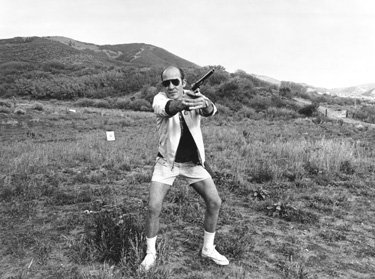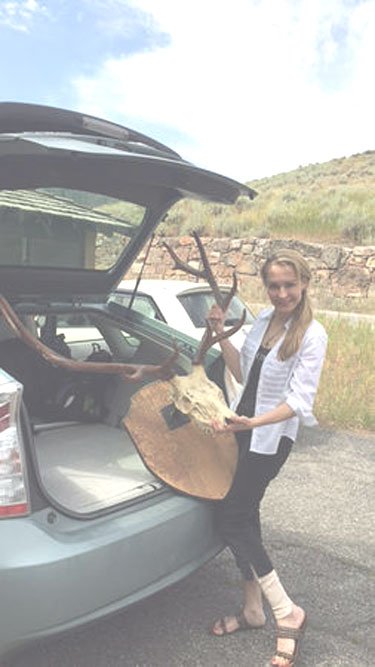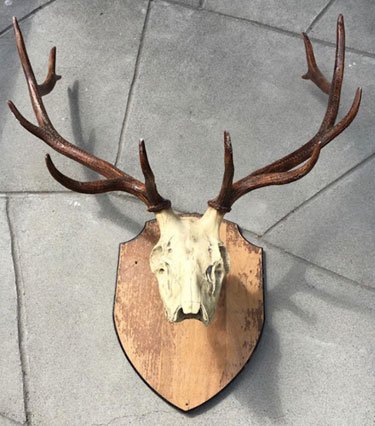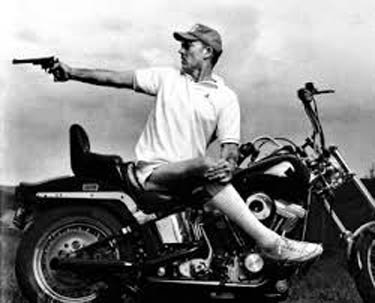Category Archive 'Hunter Thompson'
08 May 2022


Gerard van der Leun remembers partying with Hunter Thompson back in the Day. Good times!
Warren liked to drink and spend other people’s money on himself and writers. Naturally, such a honey pot was going to attract Hunter Thompson. Thompson liked to drink, snort coke, and spend other people’s money on articles he might or might not write. A favorite item from the day was the time Hunter rented a car on Scanlan [Magazine]’s credit card. He then parked it next to one of his North Beach Beatnik bimbo’s apartments and went to and fro with it for a number of months. When the time came to return the car it was discovered that the rental fee would be much much more than Hinkle and Scanlan’s wanted to spend. Their solution? After a night of beer, bourbon, and bongs, they drove the car out to the end of a pier in San Francisco, stepped out, and let it drive itself into the bay. Then they reported it stolen.
Beer. Bourbon. Bongs. Bay. What can I say? Good times.
Sometimes the small staff working with me at Organ and the larger staff working the con with Warren at Scanlan’s would decide to drink together. We liked to drink at our bar of choice up at the end of the alley, Andre’s.
One night, when Hunter was in town, we all went up to Andre’s for a non-stop night of drinking.
Andre was an elegant French-Canadian who ran an elegant bar and restaurant. He was old-school and could mix any drink anyone could name and it was always perfect. He was polished, polite, and a good listener. But he was a pro and usually knew when you’d had enough. Then he politely asked you to leave. If you ignored him, he had a very large mallet with a three-foot handle behind the bar and you didn’t ignore that.
So there we were, eight or ten of us I think, hanging around and drinking with “Hunter S. Thompson, man!” And, as they would, Warren and Hunter got into a drinking contest — sort of like watching a match between Ali and Frazier in their prime.
It went on and on long past the point where I could or would keep up. It was getting late and Andre announced to the assembled cross-eyed drunks, that he was giving us our last round. The regulars took him at his word, but Hunter had to push the envelope. Except with Andre, there was no envelope. Just a polite, “Non.”
The next thing I know there’s a gun in Hunter’s hand and three rounds blasted into the ceiling of the bar. (Did I mention that there were apartments where people were sleeping above the bar?)
Then I think there was a blur of Andre, in suit and tie, coming over the bar with the mallet. Then more blurs and everybody is out on the street dragging a semi-conscious Hunter back down the alley mumbling something about getting his gun back. After that I don’t remember much and, frankly, haven’t thought all that much about Thompson in the nearly 50 years that have intervened.
RTWT
12 Nov 2021


Kevin Mims, in Quillette, reviews High White Notes: The Rise and Fall of Gonzo Journalism by David S. Wills with a very amusing account of just how huge an asshole Hunter Thompson really was.
Every few pages of Wills’s book brings another example of Thompson screwing people over. Thompson always had difficulty with self-discipline, but his inability to produce any work was exacerbated by his cocaine abuse. This was certainly bad for his career. But it was also bad for the careers of those in his orbit. Steadman joined Thompson in Zaire where Rolling Stone had sent them to cover the Ali-Foreman fight. Steadman was eager to see the fight, but Thompson told him, “I didn’t come all this way to watch a couple of niggers beat the shit out of each other.” On the morning of the fight, Steadman frantically tried to find Thompson, who had their press passes, but Thompson had sold them and used the money to buy cocaine and marijuana. When Steadman finally found him, he was stoned and was throwing large quantities of marijuana into the hotel pool. …
When the US military began pulling out of Vietnam, Wenner asked Thompson to cover it for Rolling Stone. Thompson agreed but began to lose his nerve as his departure date drew near. Wenner asked New York Times war correspondent Gloria Emerson to try to bolster Thompson’s confidence. The phone calls between them were recorded (Thompson—like Nixon—recorded many of his phone calls and conversations), and Emerson can be heard telling him how to cover the story, passing him the details of her own contacts and translators, and offering to provide him with all the facts about Vietnam that he lacked.
Thompson finally arrived in Vietnam in April of 1975 (more than a decade after the mainstream journalists he hated began covering the story on a daily basis). He took a lot of opium, mingled with prostitutes, and generally behaved like a clown in order to entertain the other journalists, many of whom were fans of his work. But, as Wills remarks, his behavior “wasn’t as funny in real life.” The other journalists quickly realized that his antics might get him—and them—killed. At least 60 Western journalists were killed covering the war and, as Wills points out, “few of them were running around high on drugs.” Tape recordings make it clear that he was hopelessly out of his element. The other journalists can be heard laughing at his ignorance of the facts on the ground. They teased him about the fact that he hadn’t managed to write a word about the Ali-Foreman fight when Norman Mailer had managed to write a groundbreaking piece for Playboy.
Later, by himself, Thompson can be heard spitting out the words, “Fuck them!” on the recorder. At one point, stoned out of his mind and believing he was chasing “four giant fucker pterodactyls,” Thompson wandered dangerously close to the front line. Several journalists had to put themselves in harm’s way to bundle him into a jeep and drive him back to relative safety. … Read the rest of this entry »
04 May 2020


David S. Wills, in Quillette, celebrates the great and degenerate Hunter Thompson who successfully turned bad behavior into art.
[W]hen Thompson called Hinckle at three o’clock one morning in April 1970 and said he wanted to write a feature about the Kentucky Derby, Hinckle readily agreed. Thompson had been having dinner with his friend, Jim Salter, in Aspen, Colorado, when the subject came up. Salter had asked him if he was planning to attend the derby and Thompson said he wasn’t. After the spell in jail that had cost him his high school diploma, Thompson had joined the Air Force and considered his escape from Louisville to be more or less permanent. He did not particularly feel like going back to rub shoulders with the people who had looked down on him and, finally, turned their backs as he wept in a lonely courtroom.
Thompson was a night owl and, after dinner, he stayed up pondering Salter’s question. Maybe it was time to go back and see the derby. It might be the sort of thing he could write about: the outsider returns after more than a decade on the road. This needn’t be a dull article for a conservative newspaper or magazine, which was the sort of work on which he’d cut his teeth in the early Sixties. So, he called Hinckle up in the middle of the night and asked if he would pay for a flight to Kentucky plus expenses. “The story, as I see it,†he explained, “is mainly in the vicious-drunk Southern bourbon horse-shit mentality that surrounds the derby than in the derby itself.â€
Thompson’s writing was already beginning to resemble what readers would later come to call Gonzo journalism. He tended to insert himself into the prose as observer and participant, embark on weird and irrelevant digressions, recount conversations and events that probably never happened, discard any pretense of objectivity, lurch erratically in and out of hyperbole and paranoia, and dust his prose with a litany of stylistic quirks and a peculiar lexis that included words like “atavistic,†“swine,†“savage,†and “doomed.†It was a subjective, chaotic, and messy approach to journalism unsuited, Thompson felt, to the blank objectivity of a photojournalist’s camera. So, he asked Hinckle to assign him an illustrator instead.
Ralph Steadman was one of the best young cartoonists in Britain and, just like Thompson, had a wonderful talent for bringing out the inner ugliness of his subject. Neither of them liked to dress a subject up and make it look pretty; they preferred to identify a flaw and blow it out of all proportion. The art director at Scanlan’s had heard that Steadman was looking for work and called him up. On the way to the airport, he realized he’d forgotten his artist’s toolbox. He stopped briefly at the home of one of the magazine’s editors to scavenge what he could and left with eyebrow pencils and lipstick.
Among the Kentucky Colonels, Thompson and Steadman stood out like sore thumbs. Fresh from his failed Freak Power campaign for sheriff in Aspen the same year, Thompson was sporting a shaved head. He was also tall, handsome, and usually dressed in bright clothes. Steadman, on the other hand, had long hair and a wild beard. The two men should have found it easy to locate one another, but somehow it took them two days before they finally met in the press room. They immediately set about drinking and did not stop until several days after the race.
When eventually it came time to leave Louisville and produce the article and illustrations, Scanlan’s brought both writer and artist to New York and had them hole up at the Royalton Hotel. It took Steadman two days to complete his illustrations, but Thompson found himself confronted with a brutal case of writer’s block. He lay in the bathtub, slugging whisky from the bottle, and awaiting inspiration. Eventually, his frantic editors called and demanded something. The magazine was due to go to press and there was still a huge hole in the middle of the issue where Thompson’s story was supposed to go. Thrown into a panic, Thompson ripped pages out of his notebook and handed them to the copyboy. Hinckle called and declared it brilliant. Within an hour, the copyboy was back for more, and Thompson’s story appeared as scheduled in the next issue beneath the eye-catching headline “The Kentucky Derby is Decadent and Depraved.â€
Thompson later admitted that he felt guilty and ashamed about his failure to write the article. The magazine’s editors and readers, however, felt differently. It was, they thought, a triumph. The first half recounts Thompson’s arrival in Kentucky, a prank played on a gullible racist at the airport, and then his meeting with Steadman. The second half is a disjointed but somehow intensely personal account of a day spent staggering around the derby in an inebriated state, terrifying attendees and spraying a restaurant full of patrons with mace. Thompson and Steadman didn’t bother to actually watch the race they had been sent to cover. Instead, they went in search of a “special kind of face†that they hoped would allow Steadman to produce a representatively scathing portrait of Kentucky’s upper class. As they are about to despair of finding someone suitable, Thompson glances in a mirror and realizes:
There he was, by God—a puffy, drink-ravaged, disease-ridden caricature… like an awful cartoon version of an old snapshot in some once-proud mother’s fancy photo album. It was the face we’d been looking for—and it was, of course, my own.
It was a highly unusual piece of writing that trashed the conventions of traditional reporting in favor of a freewheeling rock’n’roll antagonism. It was funny but aggressive, satirical and cruel, and only loosely factual. It was neither exactly journalism nor exactly fiction… it was something in between and something quite new.
RTWT
27 Nov 2019


Vanderleun tells how he used to drink with Hunter Thompson.
I used to run a magazine (Organ) in San Francisco back in the 70s. I ran it out of the basement of a firehouse in North Beach under the offices of Scanlan’s magazine. Scanlan’s was the scam magazine of Warren Hinckle, a man whose record of conning money out of Bay Area millionaires stood unbroken for decades until the arrival of David Talbot and Salon and silly philanthropists that mistakenly married fanatic feminists.
Warren liked to drink and spend other people’s money on himself and writers. Naturally, such a honey pot was going to attract Hunter Thompson. Thompson liked to drink, snort coke, and spend other people’s money on articles he might or might not write. Sometimes the small staff working with me and the larger staff working the con with Warren at Scanlan’s would decide to drink together. We liked to drink at our bar of choice up at the end of the alley, Andre’s.
And so one night, when Hunter was in town, we all went up to Andre’s for a non-stop night of drinking. …
RTWT
19 Aug 2016


Sporting Classics:
It was roughly three years after Ernest Hemingway had committed suicide in Ketchum, Idaho. Thompson was visiting the late author’s home, trying to find what had made the area so attractive to Papa in his final days. Over the entrance to the cabin was a 6×6 set of elk antlers (it’s unclear if they were from a Hemingway hunt, but they are presumed to be). When the admiring journalist left Ketchum and headed to his home in Aspen, Colorado, so did the antlers.
That was in 1964. Some 52 years later, the antlers are back in Ketchum, returned not by Thompson himself, but by his widow.
Anita Thompson recently gave an interview to BroBible.com in which she said, “He got caught up in the moment. He had so much respect for Hemingway. He was actually very embarrassed by it.â€
Hunter, 27 at the time, wanted to understand what brought Hemingway back to Idaho after years as an expatriate in one country or another. He visited Papa’s Ketchum home while on assignment for The National Observer, then headed back to write an article about his conclusions. The antlers came off the cabin’s front doorpost and along for the ride.
Thompson never boasted about the theft; never invited friends over to see his prize. As much as the gonzo journalist loved to insert himself into stories and “tell it exactly as I saw it,†he was less than forthcoming about the antlers. They stayed in semi-seclusion for the remainder of his life, hung unceremoniously in his garage.
Read on.
—————————————–
Chicago Tribune:
A young Hunter S. Thompson went to Idaho to write about Ernest Hemingway and decided to take a piece of his hero home with him — a set of trophy elk antlers.
More than half a century later, the gonzo journalist’s wife returned the antlers to Hemingway’s house in the mountain town of Ketchum.
“He was embarrassed that he took them,” Anita Thompson said Thursday, noting the deep respect her husband had for Hemingway’s work. “He wished he hadn’t taken them. He was young, it was 1964, and he got caught up in the moment.
“He talked about it several times, about taking a road trip and returning them,” she said.
She gave back the antlers Aug. 5 to Ketchum Community Library, which helps catalog and preserve items in the residence where the author took his own life. It’s now owned by the Nature Conservancy.
In 1964, Hunter Thompson, then 27, came to Ketchum when he was still a conventional journalist. He had not yet developed his signature style, dubbed gonzo journalism, that involved inserting himself, often outrageously, into his reporting and that propelled him into a larger-than-life figure.
Thompson was writing a story for the National Observer about why the globe-trotting Hemingway shot and killed himself at his home three years earlier at age 61. Thompson attributed the suicide in part to rapid changes in the world that led to upheavals in places Hemingway loved most — Africa and Cuba. …
In the story, later collected in his book “The Great Shark Hunt,” he noted the problem of tourists taking chunks of earth from around Hemingway’s grave as souvenirs.
Early in the piece, he wrote about the large elk antlers over Hemingway’s front door but never mentioned taking them.
For decades, the antlers hung in a garage at Thompson’s home near Aspen, Colorado.
“One of the stories that has often been told over the years is the story of Hunter S. Thompson taking the antlers,” said the library’s Jenny Emery Davidson, who helped accept the trophy. “These are two great literary figures who came together over the item of the antlers.”
Davidson said historian Douglas Brinkley, who spoke at the library in May and was familiar with the antler story after interviewing the writer, contacted Anita Thompson. She called the library on Aug. 1.
Davidson said the antlers have since been shipped to a Hemingway grandson in New York who wanted them. It’s not clear if the antlers came from an elk killed by the author, who was a noted big game hunter, or if they were a gift.
Sean Hemingway didn’t respond to emails or phone messages seeking comment.
Like Ernest Hemingway, Thompson ended his own life by shooting himself, dying in 2005 at age 67 at his Colorado home.
His widow wants to turn the house where he lived and worked into a museum, planning to open it next year by invitation only. Like Hemingway’s home, it’s much the same as it was when Thompson was alive.
“I couldn’t open it with a clear conscience knowing there’s a stolen pair of antlers,” Anita Thompson said, noting the theft was unusual behavior, even by her husband’s standards.

Papa Hemingway’s Elk Antlers
09 Feb 2014


Dr. Thompson, with gun, on bike.
In 2008, James Poulos (who takes the aesthetic Bohemian approach to American political life) bought into Barack Obama’s BS. He knows better now and can be found wistfully imagining the fun if Dr. Thompson was still around to observe and comment on the hideous smoking-and-burning wreck that the current administration has made of both the American economy and democratic government. Picture Hunter Thompson, stoned on several different potent substances, writing up an essay, which Rolling Stone could not bring itself to decline, on Michelle Obama’s covert 50th Birthday Party, conducted in the manner of Elagabulus, but obligingly neglected by the lapdogs of the MSM.
Hunter Thompson is fun and easy to abuse for one’s own political purposes, but we are woefully all the poorer for having lost him in 2005, before he had a chance to discover that the power dynamic he railed against at the peak of his powers was still with us, smarter and dumber than ever. …
[T]here are now so few Democrats with even a wistful, nostalgic connection to the days when Freak Power thrived on the left. On a bad day, the landscape resembles a shameful two-species ecosystem: old corporatist behemoths casting long shadows over flea-bitten packs of communists so young and frustrated that they’re always on the verge of bursting into tears. …
We were on the back half of the Bush years. Something new, possibly even wonderful, would soon be in sight. Sure enough, the impossible happened—Hillary Clinton was beat, fair and square, by someone so sonorous about the possibilities of choice and resilience that he received the Kennedy stamp of approval, and then America’s.
Innocent times. Now, that special someone has left the crown of hope in the gutter, overwhelmed and infected by the propaganda of neediness and choicelessness that fuels the rule of fear over so much of our daily life. Progress has somehow gone from an inspiring option to an individual mandate—a grim necessity we are obliged to grind out. …
This was the touchstone of Obama ’08. Now it goes all but untouched. There was a dazzling gonzo streak to Obama’s insurgent campaign—a sense not of historical inevitability but of people, real people, going off on an incredible tangent, so crazy it just might work. The mood of the moment was nearly the opposite of today’s Obama, with his nationalistic claptrap about how “America doesn’t stand still.â€
No, Mr. President, we don’t. We shift with unease from one foot to the other. We fretfully pace the floor. America is becoming a waiting room.
We’re waiting for more shoes to drop. The nagging, nervous energy that dominates our personal and political lives belies the harsh lesson of executive action: the more constant the crisis, the more impotent it is apt to grow.
Two hundred years ago, the French liberal Benjamin Constant saw the same pathology in Napoleon Bonaparte’s waning days of despotism. Trapped in the cycle of permanent emergency and perpetual action, he wrote, “servitude has no rest, agitation no pleasure.â€
Your are browsing
the Archives of Never Yet Melted in the 'Hunter Thompson' Category.
/div>

Feeds
|












